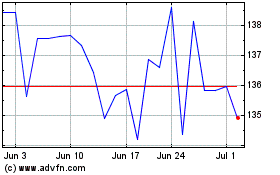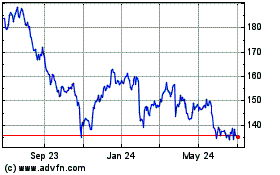Stronger U.S. Demand Bolsters Profit at UPS -- 2nd Update
October 22 2019 - 11:07AM
Dow Jones News
By Paul Ziobro
United Parcel Service Inc. benefited from a continued surge in
overnight air shipments in the third quarter, as speedy next-day
delivery increasingly becomes the standard for online orders.
The delivery company also announced the departure of Chief
Operating Officer Jim Barber, who since his appointment to the role
in March 2018 was viewed as the top candidate to replace Chief
Executive David Abney. Mr. Barber, 59 years old, is retiring at the
end of the year, the company said, opening up the CEO succession
race.
Mr. Barber, a 35-year UPS veteran, returned to the U.S. from a
long stint working internationally to help improve performance in
domestic operations. His promotion to COO made him a
CEO-in-waiting, as Mr. Abney previously held that position briefly
before becoming CEO in 2014.
Mr. Barber helped oversee the increasing automation of the UPS
network and new procedures that resulted in a solid peak holiday
season last year, earning him praise on Wall Street.
Citi analyst Christian Wetherbee said Mr. Barber was "well-liked
by the investment community" and that losing an executive "seen as
an operational catalyst likely will weigh on shares."
Mr. Abney said Tuesday that the company still has a strong
bench, including a mix of longtime UPS executives and some new
outside hires, that will be able to carry out the company's recent
major changes.
Shares fell 3.2% in early trading to $114.71.
UPS said the high demand for next-day shipping, with volume up
24% in the U.S., and strong cost management helped the company
boost profit in the period. Overall U.S. volume rose 9%.
The gain in air shipments comes as Amazon.com Inc., the largest
online retailer in the U.S., recently ended its shipping contracts
with UPS rival FedEx Corp. and is increasingly promising to deliver
orders to homes the next day. Other online merchants also are
trying to keep up with faster shipping speeds, which UPS expects to
continue to occur during the coming holiday season and beyond.
"We expect demand to be strong during peak as next-day delivery
increasingly becomes the new standard," Mr. Barber said on
Tuesday's earnings call.
UPS is working to lower the cost of delivering each package,
including air shipments, where carrying more online orders that are
generally lighter and cheaper to ship is driving down the average
price per shipment.
The company is achieving that in part from more automation. It
is adding nearly 5 million square feet of "highly automated"
facilities this year that can sort about 400,000 packages an
hour.
Mr. Abney said that despite softness in industrial production
and weaker global growth, a strong U.S. consumer is lifting the
company as more shopping is done online. "The consumer continues to
drive the economy," Mr. Abney said.
Overseas, UPS's international business posted a decline in
revenue amid a drop in shipments between the U.S. and Asia. Other
shipments inside Europe and in other Asia trade lanes grew.
For the period, the Atlanta-based shipper posted quarterly
earnings of $1.75 billion, or $2.01 a share, up from $1.51 billion,
or $1.73 a share, a year earlier. Excluding certain transformation
costs, per-share earnings were $2.07, slightly topping the estimate
of analysts polled by FactSet.
Revenue increased 5% from the year prior to $18.32 billion,
slightly under the consensus estimate.
The company backed its earnings guidance for the year.
Micah Maidenberg contributed to this article.
Write to Paul Ziobro at Paul.Ziobro@wsj.com
(END) Dow Jones Newswires
October 22, 2019 10:52 ET (14:52 GMT)
Copyright (c) 2019 Dow Jones & Company, Inc.
United Parcel Service (NYSE:UPS)
Historical Stock Chart
From Mar 2024 to Apr 2024

United Parcel Service (NYSE:UPS)
Historical Stock Chart
From Apr 2023 to Apr 2024
